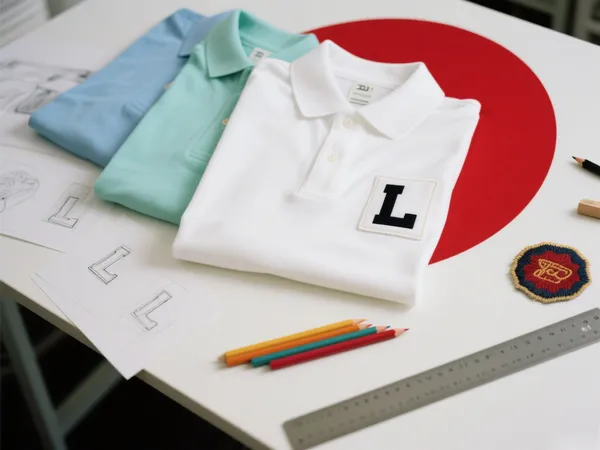Nakış yamaları, logoları, takım ruhunu veya marka kimliğini sergilemenin zamansız bir yoludur. İster üniformalar, ister moda veya promosyon ürünleri olsun, anlayış nakış yamaları nasıl yapılır fabrika perspektifinden bakıldığında yüksek kalitede sonuçlar elde etmenizi sağlar.
Bu kılavuz, tüm adımları kapsar nakış yaması üretim süreciTasarımdan bitişe kadar, bir üründe nelere dikkat edilmesi gerektiğini vurgularken, özel nakış yamaları üreticisi.

Adım 1: Tasarım Hazırlığı ve Dijitalleştirme
Üretim başlamadan önce, sanat eserinizin nakışa uygun hale getirilmesi gerekir:
Temel Tasarım Hususları
- Dosya Türü: Vektör dosyaları (AI, EPS) temiz kenarlar için en iyi şekilde çalışır.
- Stitch Density:Çok fazla dikiş yamaları sertleştirebilir; çok azı ise seyrek görünebilir.
- Renk Eşleştirme: Doğruluk için Pantone (PMS) renklerini belirtin.
Fabrika Süreci:
- Tasarım özel yazılımlar (Wilcom veya Tajima gibi) kullanılarak dijitalleştirilir.
- Bir teknisyen, optimum dokuyu elde etmek için dikiş türlerini (saten, dolgu veya koşu dikişleri) ayarlar.
- Üretimden önce dijital prova onaya gönderilir.
Adım 2: Malzeme Seçimi
Fabrikalar dayanıklılığı garanti altına almak için özel malzemeler kullanır:
- Kumaş Tabanı: Genellikle sertlik için dimi veya keçe.
- İplik: Renk dayanıklılığı için yüksek kaliteli polyester veya rayon.
- Destek: Ütüyle yapışan, Velcro® veya dikmeli seçenekler.
Profesyonel İpucu: Saygın bir özel nakış yamaları üreticisi Toplu siparişlerden önce test edilmek üzere malzeme numuneleri sunacağız.
Adım 3: Nakış İşlemi
Fabrika ortamında yamaların nasıl yapıldığı şöyledir:
1. Çemberleme ve Sabitleme
- Kumaş, buruşmayı önlemek için sabitleyici destekli bir nakış makinesi kasnağına sabitlenir.
2. Makine Nakışı
- Çok başlı makineler (6-12 iğne) tasarımı yüksek hızda işler.
- Her renk sırayla işlenir ve iplik değişimleri otomatik yapılır.
3. Kalite Kontrolü
- Teknisyenler gevşek iplikler, yanlış hizalanmış renkler veya gerginlik sorunları olup olmadığını kontrol eder.

Adım 4: Kesme ve Bitirme
1. Lazer veya Kalıp Kesim
- Hassas lazerler yamaları şekillere (daireler, dikdörtgenler, özel dış hatlar) keser.
- Isıl işlemle yapıştırılması kenarlardaki yıpranmayı önler.
2. Destek Uygulaması
- Ütüyle yapışan:Isı ile aktive olan yapıştırıcı yama üzerine bastırılır.
- Velcro®: Taktiksel kullanım için kancalı arka kısım dikilir veya yapıştırılır.
3. Son Muayene
- Yamalar paketlenmeden önce kusurlara karşı kontrol edilir.

Adım 5: Fabrikadan Sipariş Verme
Biriyle çalışırken özel nakış yamaları üreticisi, sormak:
- Minimum Sipariş Adedi: Genellikle 50–100 parça (numune paketleri için daha düşük).
- Turnaround: 2–3 hafta (acil seçenekler için ekstra ücret alınabilir).
- Test: Üretim öncesi numune talep edebilir misiniz?
Kaçınılması Gereken Kırmızı Bayraklar:
- Dijitalleştirme kanıtı sunmayan tedarikçiler.
- Net bir kalite kontrol süreci yok.

Fabrika Üretimi Neden Önemlidir?
Küçük dükkanlar maliyetleri kısabilir, ancak profesyonel fabrikalar şunları sunar:
- Tutarlılık:Büyük siparişlerde aynı yamalar.
- Gelişmiş Ekipman: Daha hızlı çıktı için çok kafalı makineler.
- Expertise: Karmaşık tasarımların (örneğin, degradeler, küçük metinler) işlenmesi.
Nakışlı Yamaların Yaygın Uygulamaları
- Corporate Branding:Çalışan üniformaları, promosyon ürünleri.
- Askeri ve Polis: Birlik rozetleri, rütbe işaretleri.
- Moda: Kot ceketler, şapkalar, çantalar.
Çözüm
Anlamak nakış yamaları nasıl yapılır fabrika düzeyinde doğru olanı seçmenize yardımcı olur özel nakış yamaları üreticisi ve kaliteyi garantileyin. En iyi sonuçlar için tasarım hazırlığına, malzeme seçimine ve üretim şeffaflığına odaklanın.
Toplu siparişlerde her zaman numune isteyin ve kalite kontrollerini onaylayın; bu, revizyonlarda zamandan ve maliyetten tasarruf sağlar.



